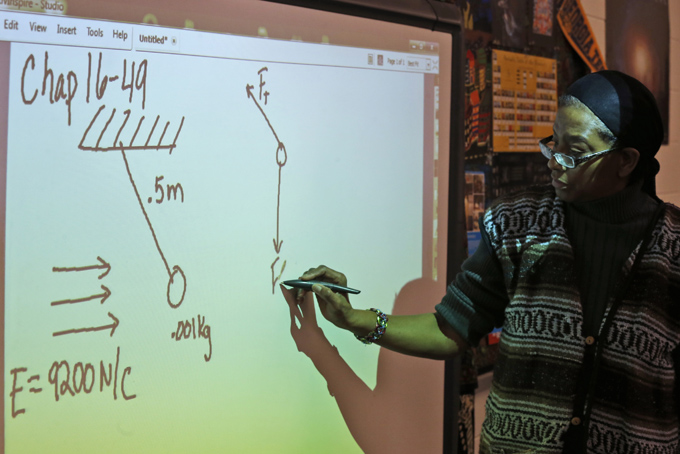
WASHINGTON (AP) — Columbus McKinney is taking his fifth Advanced Placement course at Woodrow Wilson High School in Washington, undeterred even though he didn’t score high enough to get college credit on two of the AP classes he took previously.
McKinney said he thinks the extra workload is worth it no matter the grade on the final exam. “It prepares you for what it’s going to be like when you get to college,” the 17-year-old said during a break from his AP Physics course.
McKinney is part of a larger trend: The number of U.S. public school students taking Advanced Placement classes nearly doubled over the last decade. The class of 2013 took 3.2 million AP exams, according to a College Board report to be released Tuesday.
Advanced Placement exams, which started in the 1950s, offer a way for students to earn college credit while still in high school and are offered in 34 different subjects. The classes are designed to be rigorous and are graded in a uniform way, meaning students’ grades from one school can be matched up against those from another. Proponents say they help transition students to college and allow graduates to stand out in the college admission process.
Much of the expansion stems from an effort at the district, state and federal levels to make AP classes available to low-income and minority students. The report finds that the number of low-income graduates who took an AP exam has quadrupled in the last decade.
The College Board points out there’s room for more expansion: About 40 percent of public U.S. high schools don’t offer any AP classes. And nearly 300,000 students who were identified by standardized tests as having potential to succeed in AP graduated without taking the classes. It is reaching out directly to students identified as potentially ready for AP classes to encourage them to take them and has teamed with Google to get more female and minority students into AP science and math classes.
There are questions, though, about whether doors to AP classes have been opened too wide and whether schools are doing enough to assist students in them.
In 2013, about 57 percent of AP exams had a score of 3 or higher — the grade many colleges and universities require to award college credit — compared with 61 percent a decade earlier, according to the College Board. That means students did not score a 3 or higher on about 1.4 million exams.
Looking at it in another way, about 20 percent of graduates in 2013 earned a 3 or higher on an AP exam, compared with about 12 percent of graduates in 2003.
Research is unclear on whether there are long-term benefits to taking an AP class if the student fails, said Kristin Klopfenstein, executive director of the Education Innovation Institute at the University of Northern Colorado, who has studied the issue. Among those students, she suspects it’s only those who were on the cusp of passing who get much benefit.
Klopfenstein said from an equity standpoint, it’s good to increase the availability of AP classes. But students may not truly have “access” to the exams unless they’ve been given a quality education to prepare them for the class or extra support to help them succeed.
“Access is much more than about offering the courses, it’s about offering wrap-around support, so that kids who are coming in farther behind have a chance to take AP and actually be successful,” Klopfenstein said.
Philip Sadler, a Harvard University professor who has also studied AP outcomes, said that for some students coming in unprepared for AP level work, it would be like enrolling in an advanced French class without having taken a previous French class. “AP can be a really good thing for the right student,” Sadler said.
At McKinney’s high school, which is in an affluent part of Washington and has a diverse population from around the city, more than 20 AP classes are offered. About 600 students took an AP exam last year — about twice as many as a decade earlier. The doubling wasn’t an accident.
Principal Peter Cahall said when he arrived at the school about five years ago, he noticed that almost all the honors and AP classes were taken by white students. An effort was made to bring more students into AP classes if they had scored high enough on standardized tests to indicate they could do AP-level work. No student who wants to take an AP class is turned away.
“Sometimes you have to invite kids and say, you can do this,” Cahall said.
As the number of students taking the AP classes at the high school has doubled, the percentage of students passing the exams with a 3 or higher at his high school has remained consistent at a little less than 50 percent. Cahall said the school’s goal is to improve pass rates. With the assistance of a grant, the school is offering extra prep time and mock exams for the students on Saturdays.
In McKinney’s AP physics class, students excitedly surrounded teacher Angela Benjamin’s desk on a recent day as purple glowed from a plasma globe in the darkened classroom.
Benjamin said there’s no doubt in her mind that students benefit from her class even if they fail the AP exam. She said she became a believer about 10 years ago when two students who sat in the back of her class could orally answer all the questions, but didn’t pass the AP exam. She said she later learned they took physics and engineering in college.
“I don’t think either one of them would’ve done that without that class,” Benjamin said.
_____
Online:
https://apreport.collegeboard.org
_____
Follow Kimberly Hefling on Twitter at https://twitter.com/khefling